Our recommendations are made independently. We may receive commissions from purchases made via our links.
Charcoal vs. Gas Grills: Differences, Pros & Cons, & Conversion Guide
The charcoal vs. gas grills rivalry and their arguable superiority spark heated debates among grillers. We’ll resolve this once and for all.
We could talk about the charcoal vs. gas grills rivalry for hours on end. After all, this is one of the most hotly debated discussions for grillers when the topic shifts to BBQ superiority.
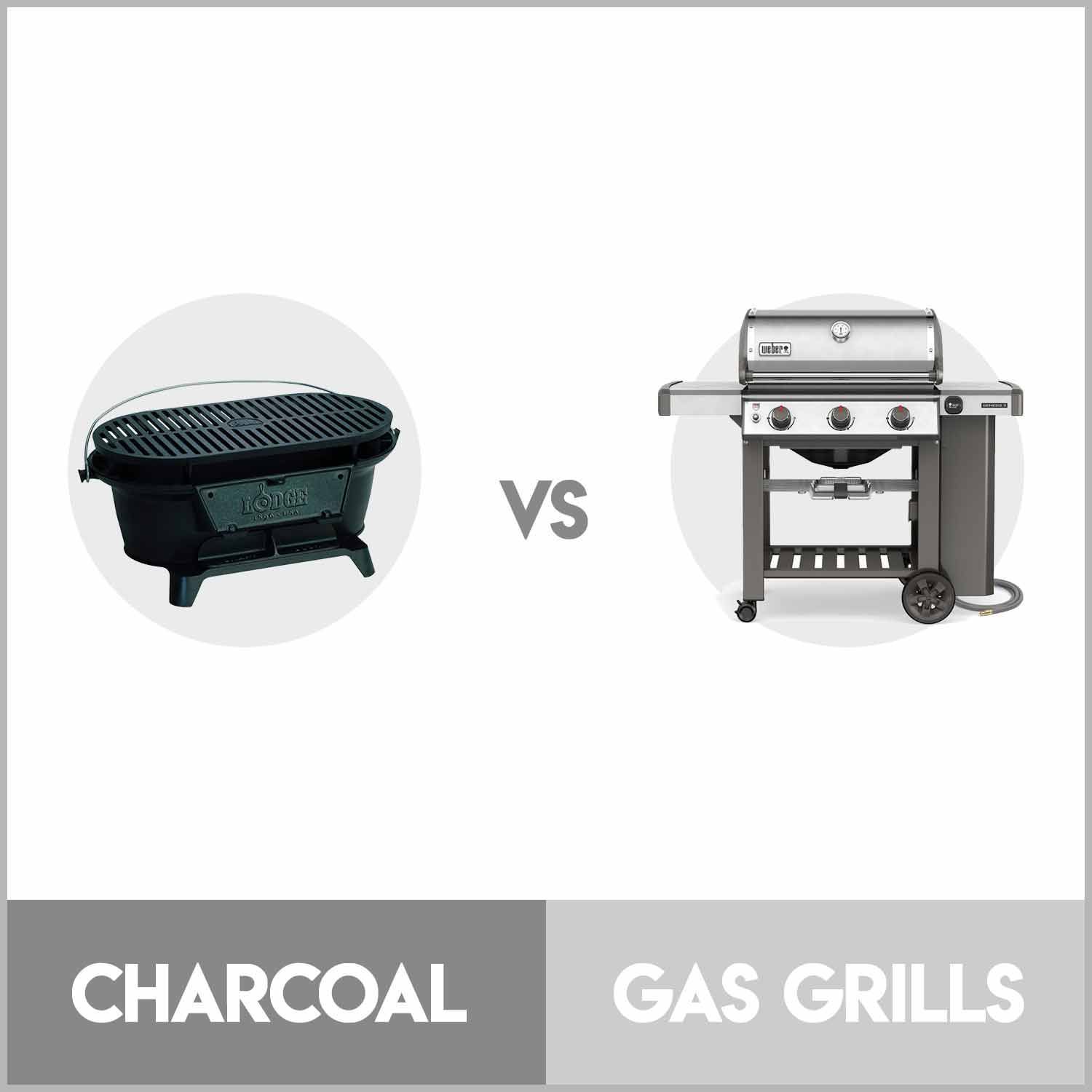
For any avid griller, if you’re not picking one, then it has to be the other. More often than not, grillers defend their choices by making compelling cases and logical arguments— all of which are fair points, no less.
For this entry, we’ll see how these two forms of BBQ go head-to-head based on various criteria. Each grill has its own strengths and shortcomings, and we’re going to divulge them all for the grillers’ sake.
Differences Between Charcoal vs. Gas Grills
In a way, comparing charcoal & gas grill is somewhat the greasier version of the classic apple-orange comparison.
From the get-go, the names themselves are indicators of how these two forms of barbecue are worlds apart.
While both grills have signature strengths, they also bear shortcomings— both subtle and glaring alike. Spoiler alert: none of these grills are all-around perfect. But they certainly are up for challenges in certain situations, or at least able to meet specific needs or demands.
While it’s almost impossible to draw out an all-encompassing conclusion, we can break things down into smaller criteria where the two grills go head-to-head. That way, you can decide which grill ticks all your boxes.
Popularity & Price
Before the emergence of high-efficiency energy and innovative heating gizmos, charcoal grills reigned supreme and held the sole title of the ultimate barbecue. Even to date, they remain popular among BBQ communities— which is to say a thing or two about their timelessness.
And more often than not, every griller’s first-ever purchase is a typical, traditional charcoal grill. It’s an inexpensive and straightforward way to practice your skills and up your confidence to a certain level before committing to something more serious or expensive.
But as things get better over time, charcoal grills are now gradually losing ground to gas grills.
Gas grills are becoming more prominent and even more appealing to grillers with impressive user-friendliness and an abundance of extras. They’re available for purchase at multiple price points, depending on what features you need and how big a budget you have.
But one thing is for sure: they aren’t going to be cheap.
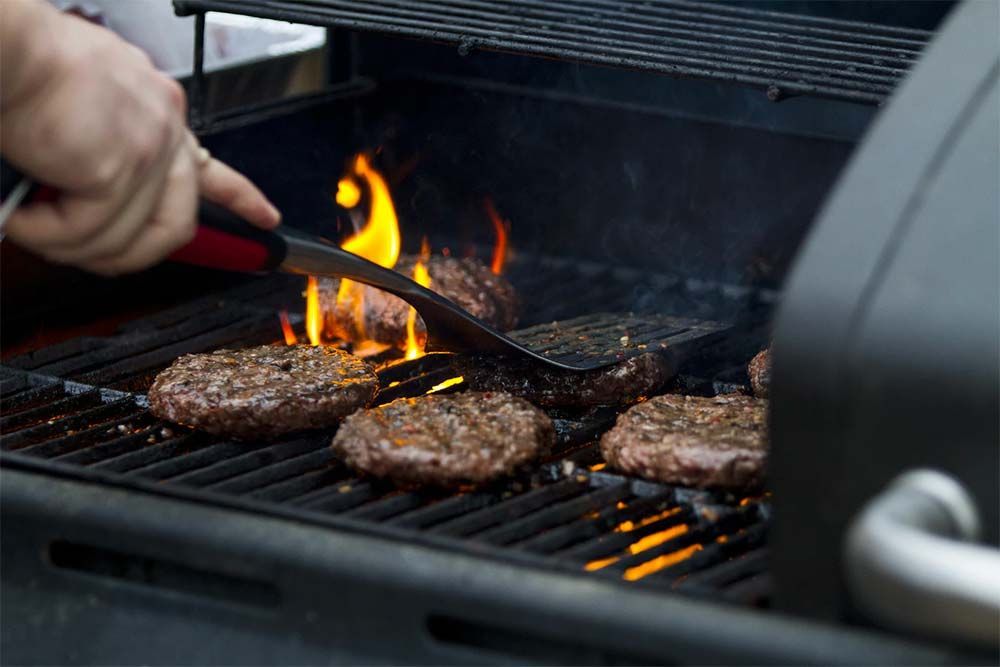
Gas grills can rack up hundreds— if not thousands— of dollars, much more expensive than charcoal given their complicated setup and configurations needed to operate. But that hardly deters grillers from buying whatsoever, as you can deem it a worthwhile investment that would pay back in the long run.
Heating Capacity
Given how both grills run on combustible fuels to produce open flames, they share virtually the same heating prowess, and such assessment is close enough.
The gist is the more fuel you add, the hotter the flames get. Other than searing directly right above the naked fire, both grills are also adept at grilling indirectly— perfect for large, chunky items to cook their way to perfection, like ribs, briskets, or birds of various kinds.
Aside from the (nearly) identical heating performance, each grill has something extra to offer that the other cannot.
Charcoal grills accentuate the food’s flavors by infusing/permeating them with smoke. That way, steaks will further marinate with a wood-burnt aroma and bear those hallmark pinkish smoke rings between fibers, provided you cook them correctly.
Plus, you get to experiment with different types of flavored wood chips. The options and combinations are entirely up to your culinary creativity and at your disposal: hickory, mesquite, apple, cherry, pecan, oak, peach, and whatnot.
But the trade-off is the insane amount of smoke released from burning chunks of briquette and woodchips. Inhaling too much of the fume is rather unhealthy, so bear that in mind.
As for gas grills: since the fuels are clean-burning, gas grills burn fuels effectively with high efficiency. That way, smoke is kept to the minimum.

Though the smoking ability is somewhat inferior to that of charcoal grills, gas grills try to salvage this by employing heat shields— metal plates covering the burners from grease splashes and juices— and offset smokers. You can even find separate side burners or infrared heaters on some gas grill models, too.
While the definite winner remains unclear, one thing is for sure: both grills offer way more heating than those electric grills.
Temperature Control
Gas grills offer temperature fine-tuning with pinpoint precision and ease of control: simply turn the knobs/dials to adjust the flame’s size as needed. Getting the flame started/snuffed is equally effortless, quick, and hassle-free.
To further improve their chances with buyers, gas grills often have fast preheating time— a major blessing if you need to whip up a quick meal in a hurry. The preheating process takes no more than a few minutes of waiting, which is virtually nothing compared to the effort of getting the coal lit.
Once gas grills get hot, they stay hot. These grills hold the temperature constant— or at least keep fluctuations within check.
Quite a shame that charcoal grills cannot offer the same conveniences. If anything, you can expect all sorts of hassles when changing temperatures.
Right off the bat, igniting coal chunks is already posing enough trouble on its own. The process gobbles up 10 minutes up to half an hour only to make feeble embers and occasional sparks.
While a chimney charcoal starter is an inexpensive and common way to build a fire, it’s time-consuming and effort-taking.
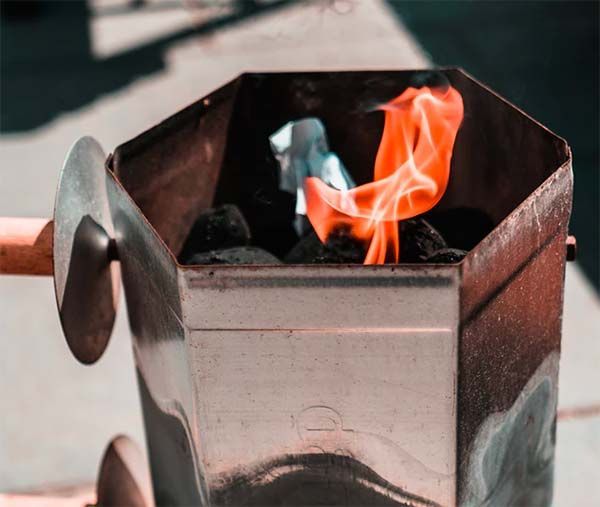
Other faster methods include electric charcoal starters, blowtorches, and lighter fluids. Faster as they are, do be careful— potential injuries and fire hazards loom large.
The moment the coal is lit, you won’t have a spare minute to laze around: you’ll be constantly tending/stoking the coal to keep the fire going.
A certain amount of oxygen must be regulated carefully and monitored throughout cooking to ensure the fire is optimum. The key toward mastering charcoal barbecuing is finding the right balance: the coal is not to be starved of oxygen but not overfed either.
- Too little oxygen: the coal creates more smoke, eventually snuffing the flames
- Too much oxygen: the fire gets over control, the grill overheats, major flare-ups & injuries loom.
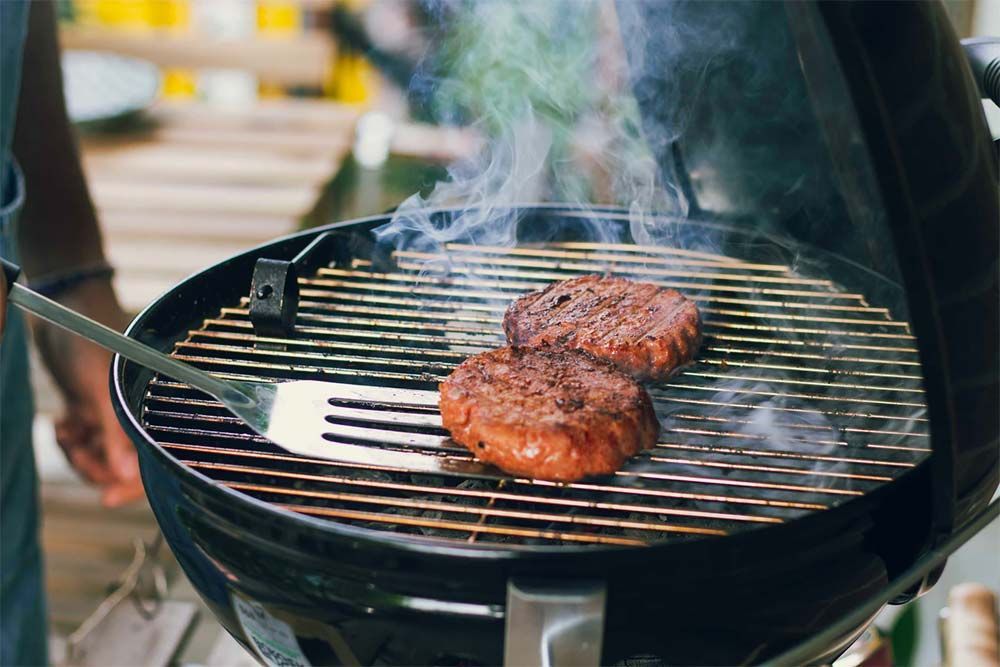
But ultimately, what upsets us no end is that the temperature doesn’t change instantaneously. Eventually & gradually, the effects would set in, but sometimes the differences aren’t even that noticeable to the untrained eyes.
Premium charcoal grills try to improve this situation by using height-adjustable grates to raise/lower the coal bed toward the grate. While the thought is appreciated, this design can only help so much.
Given there isn’t a pinpoint temperature control, all you can do is open/close the vents or draft doors to allow/restrict air entering the coal bed. So, our advice is to be patient and in no circumstances should you overcompensate the changes to speed things up.
This is especially true when you’re cooking with ceramic grills, also known as kamado grills— granted these grills aren’t typical charcoal grills, but they use charcoal nonetheless; thus the reason stands.
And don’t even get us started on the extinguishing: once the party’s all wrapped up, the coal must be cooled off completely before discarding— either by drowsing with water or air-cooling by themselves. Either way, it’s another mess you’d have to clean up, as if the greasy gunk inside the grill isn’t enough already.
Cleaning Ease
When cleaning o’clock strikes, both grills have their fair shares of grease and grimes. Under normal circumstances, you can clean the exterior and detachable components as usual— common dish soap and a little elbow grease should take care most of the mess, even the most stubborn stains would come off with specialized, all-purpose foams or formulated cleaners.
But cooking with charcoal grills means you also have to deal with ashes, soots, and burnt food— all of which falls through the grate and gathers in the coal bed. Nonetheless, dealing with these residues is somewhat easy:
- Sift through the ash for unburnt coal chunks & collect with heavy-duty tongs. Discard or reuse as needed.
- Cool off the ash— either douse with water or air-dry— till you can safely vacuum everything.
- Clean other parts as usual. Here are our detailed instructions on how to clean a grill.
For gas grills, they don’t pose major cleaning hassles at first, but they will in due time. Inside gas grills, there is a grease tray that collects grilling residues— grease, meat juice, and charred bits falling through grate bars— which helps reduce cleaning efforts for you. Awesome.
But somehow if smaller particles escape the tray, they would fall further inside the cookbox and make their way to the burners through the holes. And this poses a series of problems to come.
Left uncleaned long enough, grease and gunk coagulate and clog up the burner tube, severely hampering the grill’s overall performance and life expectancy. If you neglect any further, the grills are as good as ruined due to numerous factors:
- Rust buildup from poor maintenance & oxidation,
- Clogged burners from grilling residues & spider webs,
- Mold buildup from disuse & moisture (from rain, dew, and snow).
- Caked-on grates from leftovers.
Eventually, you’ll have to deep clean everything from inside out at some point in the future— meaning you’d take every grill components apart, give them a soapy bubble bath, dry thoroughly, and reassemble everything in order. It’s recommendable to do it in a two-three month interval to keep orifices well-ventilated and all things squeaky clean.
Portability
Since barbecuing is among the most popular camping & outdoor activities, manufacturers try to find ways to make their grills as mobile and versatile as possible.
Except for natural gas grills— which are to be confined to a fixed spot and too bulky for traveling— you can expect to find casters or wheels on grills nowadays, regardless of fuel source. The added mobility will make all the differences in the world when the weather tries to sabotage the grill fest.
There are also compact & portable grills you can fit inside your car or an RV for road trips. They can sit nicely on any flat surface— like the counter or tabletop— and don’t take up too much space.
Safety
Both grills are subject to major flare-ups with fatty food. Grease and juice from meat drip off grate bars and into open flames, bursting into sudden and violent fireballs that catch grillers off-guard. Eruptions like those are highly dangerous for everyone in close proximity.
Flare-ups are major concerns and they aren’t something to be messing around with.
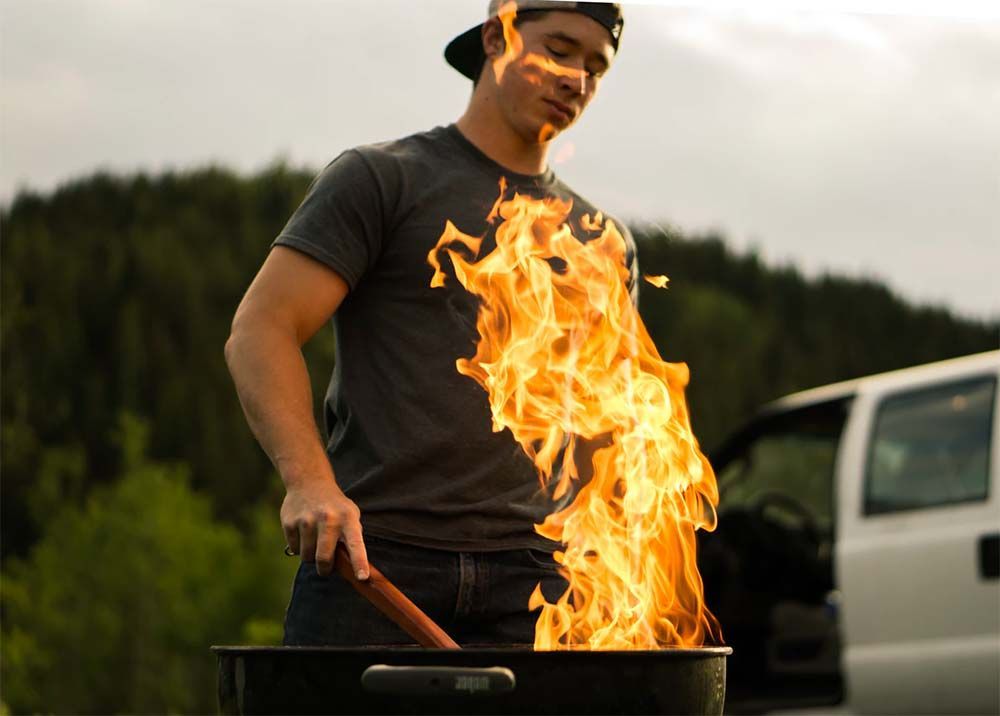
Countermeasures for flare-ups are taken seriously by manufacturers. On gas grills, you will spot metal plates hovering above the burner tube known as flavorizer bars or heat tents. These plates shield the burner orifices from small droplets of grease and oil coming from above, keeping the burner operating at maximum capacity and free of obstruction.
As for charcoal grills, there isn’t an effective way to keep the fire in check other than the lid.
Another mention-worthy concern when cooking with kamado grills is backdrafts— violent bursts of fire due to a sudden oxygen influx upon opening the lid all the way. In a way, a backdraft is similar to a flare-up, but the difference lies in how the fire gets out of control: one is burning fat while the other is oxygenated fuel.
To counter backdrafts: open and close the lid little by little a few times before completely opening it. This process— dubbed burping the grill— slowly introduces oxygen inside the grill, which prevents the fire from escalating beyond control.
Since flare-ups are a common theme during barbecuing that will eventually come up in one way or another, let’s try to keep things safe for grillers. Our tip: trim off the fat and preheat the grill well before cooking
Extra Features
This is the part where a gas grill proves why it is well worth the price tag its rich arsenal.
Other than immense cooking prowess, a gas grill further provides a good sense of comfort and convenience for those manning the BBQ station for an extended period. Gas grills often come with a wide range of add-ons like:
- Lid-mounted thermometer,
- Rotisserie system for birds,
- Side tables for condiments and dressings,
- Tool hooks,
- Bottle opener,
- Cabinets and racks
- Overhead grill light (exclusive to premium models)
Given their rather hefty cost, gas grills are often placed under an extensive warranty period, with specific components guaranteed to operate up to a few years before completely giving out.
Charcoal grills, on the other hand, don’t have many additional features. Other than casters/wheel, cart, and occasional tool hooks, there’s little to none to expect from charcoal grills as extras.
Gas or Charcoal Grill: Which is Better?
In the end, the final decision is entirely up to you. After considering each grill’s virtues and faults, personal preference is still at play. Regardless, it’s an important factor that should be taken into the equation.
If taste & authenticity are paramount to you: go for charcoal grills.
If ease of use & convenience are the deal-sealers: go for gas grills.
How to Convert Gas Grill to Charcoal
When a gas grill is damaged beyond repair or has fully run its course— a few years from purchase up to a decade, tops— it’s time you considered retiring them.
But if replacing/purchasing a brand-new gas grill is out of the question, you can convert a gas grill to a charcoal-fed grill, saving yourself quite a considerable sum.
Disclaimer: Please be advised that the conversion is permanent & irreversible. In addition, there’s a chance that the converted grill may underperform. Proceed at your own discretion and caution.
- Clean & de-rust the grill using specialized cleaners;
- Remove gas components— burner tube, flame tamers, gas valve, hose, temperature knobs, etc.
- Cover the grill’s bottom with a metal sheet with high heat tolerance and durability— preferably stainless steel 304 or 316. Another alternative is an oven tray. This is where you’ll be loading the coal.
- Secure the base into the grill via screws/welding and cover the base with a layer of tin/aluminum foil.
- Reuse/replace the grates as needed.
- Make draft doors & vents to regulate the heat.
The final step involves heavy machinery and metalwork, so if you choose to proceed, do be careful and consult a professional as needed.
Pros and Cons of Charcoal vs. Gas Grills
For your convenience, here’s the sum-up comparison table.
| Charcoal Grills | Gas Grills |
|---|---|---|
Pros | ||
Cons |
- Expensive
- Routine “deep cleaning”
- Safety concerns
- Fuel shortage & replacement (LP models)
- Complicated temperature setting
- Time-consuming to ignite the coal
- Easy-controllable temperature
- Easy-start ignition
- Multiple add-ons and extra features
- Typically bigger
- Multiple-zone cooking
- Longer warranty
- Diverse spare parts & replacement components
- Inexpensive
- Less cleaning hassles
- Authentic BBQ flavor & experience
- Can function as smokers (using dampened wood chips)
- Cheap fuel
- Smokey flavor
- Searing prowess
Conclusion
We hope this comparative entry of charcoal vs. gas grills has been both helpful and informative for grillers. If there is anything we’re missing, or if you feel like sharing tips or experience, please don’t hesitate and head straight to the comment section.





